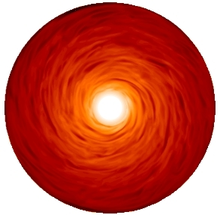Wladimir Lyra
Associate Professor
New Mexico State University
Department of Astronomy
PO Box 30001, MSC 4500 Las Cruces, NM 88003
wlyra - nospam - nmsu.edu
+1 575-646-1400

Menu:
PhD Thesis
My thesis work, "Turbulence-Assisted Planetary Growth", is a numerical study of planet formation, employing two-phase (gas and solids) hydrodynamical and magnetohydrodynamical models of turbulent protoplanetary disks. In particular, I showed for the first time how large scale vortices concentrate solids to the point of reaching gravitational collapse into planetary mass objects, thus behaving as a very fast route for planet formation. The thesis is comprised by four papers that have collectively been cited over 500 times.
Abstract

The current paradigm in planet formation theory is developed around a hierarquical growth of solid bodies, from interstellar dust grains to rocky planetary cores. A particularly difficult phase in the process is the growth from meter-size boulders to planetary embryos of the size of our Moon or Mars. Objects of this size are expected to drift extremely rapid in a protoplanetary disk, so that they would generally fall into the central star well before larger bodies can form.
In this thesis, we used numerical simulations to find a physical mechanism that may retain solids in some parts of protoplanetary disks long enough to allow for the formation of planetary embryos. We found that such accumulation can happen at the borders of so-called dead zones. These dead zones would be regions where the coupling to the ambient magnetic field is weaker and the turbulence is less strong, or maybe even absent in some cases. We show by hydrodynamical simulations that material accumulating between the turbulent active and dead regions would be trapped into vortices to effectively form planetary embryos of Moon to Mars mass.
We also show that in disks that already formed a giant planet, solid matter accumulates on the edges of the gap the planet carves, as well as at the stable Lagrangian points. The concentration is strong enough for the solids to clump together and form smaller, rocky planets like Earth. Outside our solar system, some gas giant planets have been detected in the habitable zone of their stars. Their wakes may harbour rocky, Earth-size worlds.
Download
Turbulence-assisted planetary growth
Ph.D. Thesis, Uppsala University, 2009
Uppsala Portal
[pdf]